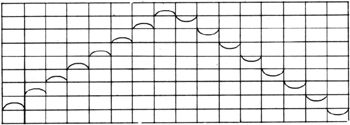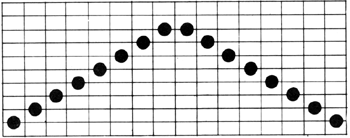Editors of this issue: Antanas Klimas, Ignas K. Skrupskelis, Thomas Remeikis,

|
LITUANUS
LITHUANIAN QUARTERLY JOURNAL OF ARTS AND SCIENCES
Volume 19, No.3 - Fall 1973
Editors of this issue: Antanas Klimas, Ignas K. Skrupskelis, Thomas Remeikis, Copyright © 1973 LITUANUS Foundation, Inc.
|

|
SIGHTSINGING IN LITHUANIA
EMILY BOTDORF SCHMALSTIEG
The Pennsylvania State University
Due to the fact that many American choral directors complain that their choristers are unable to sight-read, it might be of interest to elementary teachers to know how sightsinging is taught in Lithuania.
For the purposes of this paper, sightsinging will be defined as the ability to sing intervals, phrases, or songs at first sight.1 The paper will also be limited to the sight-singing taught in grades one to six in the regular schools of Lithuania. Although the choruses heard at the IXth Congress of the International Society for Music Education were from special schools, it should be pointed out that in these schools the same general sightsinging approach is used as in the regular music classes. Sightsinging will be described in terms of (a) methods, (b) learning theories, (c) teaching principles, and (d) implication for teaching.
Methodological Approach
In Lithuania the movable-do method is used for teaching sightsinging. The foundation for this method is laid in the first grade where students are introduced to a chart which shows the syllable names of the ascending and descending diatonic scale. The students are asked (a) to pronounce the syllables with their teacher, (b) to listen to the scale sung on syllables by the teacher, and (c) to sing a song on syllables followed by words, the melody of which is based on the ascending and descending diatonic scale.
Second grade students translate songs that they have learned by rote in first grade into solfege, thus relating the sound to the symbol. They also copy short songs from their books and name the syllables. In the third grade all the syllables but ti are studied. One syllable at a time is introduced and studied in detail. For example, the syllable sol in the key of C is played and sung by the students. The other syllables are studies in a similar fashion. Thus most of the year is spent on learning methodical rather than rhythmical aspects of music, just the opposite of the second grade.
In the fourth grade ti is studied with the same care which was given to the study of the other syllables in the third grade. Two-part songs, most of which are in the key of C, are sung and rhythm patterns are stressed. Finally, in the sixth grade students concentrate on all keys and learn new songs by the same method.
Thus with the movable-do method, students are expected to learn the syllable names of the diatonic C major scale as early as the first grade and by the sixth grade they are expected to have developed their sight-singing ability to the extent that they can sing two-part songs in all keys.
Psychological Approaches
Apparently no one psychological theory underlies the teaching of the movable-do method in Lithuania; instead a combination is employed: (a) stimulus-response association theory and (b) Gestalt-field theory.
The S-R theorist, for example, would ask students to name each isolated syllable.2 This approach seems to underly the method used mostly in grades one to four. Students in the first grade look at the ascending and descending diatonic scale and name the syllables one by one. The theory is carried one step further in second grade when the students are asked not only to name the syllables but also to copy a song from their book and identify each syllable. In third and fourth grades this note-by-note approach is continued: students take dictation which uses only sol and la; finally, more syllables are used in the dictation exercises as the individual syllables are mastered.
In contrast to the S-R theorist, the Gestaltist would expect students to hear, see, and sing a tonal configuration.3 Although most psychologists explicitly deny Gestalt theory,4 it nevertheless seems to find its application from the fifth grade on when students begin to analyze the scale in terms of intervals, arpeggios, and sequences. Patterns such as do-mi-so and do-re-mi-fa-sol are found in songs which the students learn to sight-read or write in melodic dictation.
Teaching Principles
The textbooks seem to illustrate teaching principles similar to those of Pestalozzi's: (1) encouragement of active participation and (2) teaching of but one thing at a time and continuing it until mastered.5
Active participation. Lithuanian teachers encourage student participation in the learning of sightsinging. For example, in one second-grade exercise, all students are asked to write the notes and syllable names of the ascending and descending diatonic scale on graph paper. After students write the scale with its syllables, the teacher divides the class into eight groups, each group representing a syllable of the scale. First, each group sings a single syllable as the scale progresses, then the entire class sings the scale. Having participated in the above activities, the students then are expected to apply their knowledge to sight-read a familiar song.
In order to add variety to the classroom activities the students not only sing, but they also copy songs from the music textbook and name the syllables. Moreover they look at a song, sight-read it, and from that experience identify the song. Finally, all students take melodic dictation. First they listen to the song, then they write it.
Single conceptual presentation. Lithuanian music teaching adheres to the principle that only one concept should be taught at a time. In the second grade students are first taught to read notes on lines. Note Chart 1 which is copied from the second grade music textbook. Next they look at Chart 2 which combines the concepts of Chart 1. Having been exposed to the charts, the students are then asked to sing a familiar song and raise or lower their hands respectively as the song goes up or down. After the pitch concept is learned, the students copy in their notebooks a combination of notes they have seen on Chart 1, e.g., Chart 3. Next the class is divided into groups, each one representing one syllable of the scale, and then each group sings its syllable as it occurs in the scale. Following this each student sings the scale alone and then writes the scale as in Chart 4.
Having learned how to write notes on lines as a scale and sing it, they apply the same procedure to learn to write notes on spaces as a scale and sing it.
Another illustration of the principle that one concept should be introduced at a time is furnished by the manner in which the syllable sol in the key of C is presented. In third grade the first syllable studied is sol. Students copy sol on staff paper from their books. Then they sing sol according to indicated dynamics. Finally, they sing a song written on only the syllable sol in the key of C.

Chart 1: The Meaning of a Note on a Line

Chart 2: The Meaning of Notes on Consecutive Lines

Chart 3: The Meaning of High and Low Pitches

Chart 4: The Meaning of a Diatonic Scale
The syllable la is introduced next and studied. First the students listen to the teacher sing la and compare its sound with sol. Next they copy la on staff paper as they did the syllable sol. After this they copy both sol and la on staff paper. The teacher then sings and plays a melody composed of both sol and la and the students are to raise their hands on la. Having aurally differentiated between the two syllables, they sight read a song containing the same syllables, and them take melodic dictation involving sol and la. Finally they look at a few measures from different songs and identify the songs on the basis of having sight-read them. The remaining syllables are taught in a similar fashion, each being introduced only one at a time.
Having briefly looked at the Lithuanian approach to teaching sightsinging, one might ask how it differs from the U.S. approach and what implication these differences have for the teaching of sightsinging.
This task is rendered difficult by the variety of methods used in U.S. schools: Some of the latter use (a) the Kodaly system, (b) the movable-do methods without the hand signals, (c) letter names, and (d) numbers. Using the basic music series as the method used by the majority of U.S. teachers, it appears that the Lithuanian and U.S. sightsinging methods differ in the following ways: the Lithuanian students are given (a) more varied, aural-visual learning experiences, (b) one concept at a time, and (c) more time to spend on a single concept before continuing to the next concept.
The first implication for teaching sightsinging is that by means of varied activities the sound should be related to the symbol. For example, beginning students should learn (a) to sing a song on words, (b) to analyze it pitch-wise (aurally and visually), (c) to write notes on lines and spaces, (d) to relate them by singing the scale on syllables, and finally (e) to take melodic dictation. In this way sightsinging would be taught in a cognitive structure through direct and empirical musical experiences.6 It would give students opportunities to understand conceptually the aural-visual relationship between a symbol and its sound.
The second implication is that only one concept should be introduced at one time, e.g., students should hear, write, and sing sol before continuing to learn la.
In conclusions, the writer suggests that certain features of Lithuanian music teaching be emulated in order to improve the American student's skill in sightsinging.
1 Willi Apel, Harvard Dictionary of Music (2d ed.; Cambridge: Harvard University Press, 1969), p .679; Philip Babcock Gove (ed.), Webster's Third New International Dictionary (3d ed.; Springfield: G. & C. Merriam Co., 1966), p. 1490.
2 Marilyn Pflederer, "Research in Music Education," Colorado Journal of Research in Music Education, III (Spring, 1966), p. 1.
3 W. Ralph Mc.Caw, Educational Psychology (Monarch Review Notes. New York: Monarch Press, Inc., 1964), p. 40.
4 John A. Molino, "Is There a New Soviet Psychology?" Social Thought in the Soviet Union, ed. Alex Simirenko (Chicago: Quadrangle Books, Inc., 1969), p. 309.
5 Charles Leonhard and Robert W. House, Foundations and Principles of Music Education (2nd Ed.; New York: McGraw-Hill Book Company, Inc., 1972), pp. 52-53.
6 James C. Carlsen, "The Role of Programmed Instruction in the Development of Musical Skills," Comprehensive Musicianship: The Foundation for College Education in Music, Report of the Seminar Sponsored by the Contemporary Music Project at Northwestern University, April, 1965 (Washington, D.C.: Contemporary Music Project/Music Educators National Conference, 1965), p.
56.